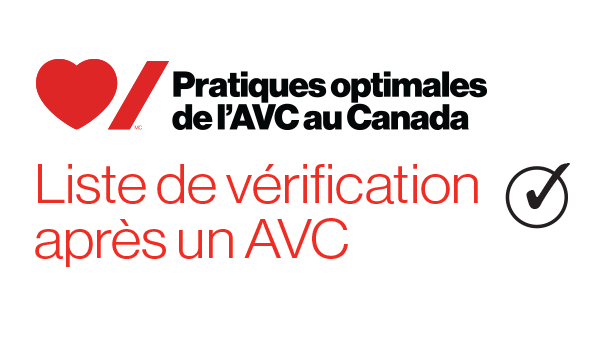- Définition et considérations
- 1. Soutenir les personnes ayant subi un AVC, leur famille et leurs aidants
- 2. Éducation des personnes ayant subi un AVC, de leur famille et de leurs aidants
- 3. Planification des soins interprofessionnels et communication
- 4. Participation communautaire après un AVC
- 5. La transition aux soins de longue durée après un AVC
- 6. Dépression après un AVC
- 7. Fatigue après un AVC
2. Éducation des personnes ayant subi un AVC, de leur famille et de leurs aidants
6ème édition - 2019 MISE À JOUR
Recommandations
2.0 L’éducation des personnes ayant subi un AVC, de leur famille et de leurs aidants fait partie intégrante des soins de l’AVC et devrait s’inscrire dans toutes les rencontres en matière de soins de santé et lors des transitions [niveau de preuve A]. Les besoins d’éducation personnalisée évoluent au fil du temps et peuvent nécessiter une réévaluation et une mise à jour continue [niveau de preuve B].
2.1 Évaluation des besoins d’apprentissage
- Les besoins et les objectifs en matière d’apprentissage personnalisé devraient être évalués et documentés par les membres de l’équipe de soins de santé [niveau de preuve B] et mis à jour régulièrement à mesure que les gens cheminent dans les stades des soins après un AVC [niveau de preuve B].
Remarque: Cela s’applique à tous les milieux, y compris les services de soins ambulatoires et des urgences, où l’interaction est plus brève et les besoins d’apprentissage risquent davantage de ne pas être satisfaits.
2.2 Prestation de l’éducation
- Un plan d’éducation personnalisé devrait être élaboré et mis en œuvre en fonction de l’évaluation des besoins et des objectifs d’apprentissage des personnes ayant subi un AVC et de leur famille [niveau de preuve B].
- Il est recommandé que le plan d’éducation personnalisé:
- Couvre tous les aspects pertinents des soins et du rétablissement de l’AVC [niveau de preuve A] et comprenne du contenu adapté au niveau de préparation, au milieu et au stade de soins [niveau de preuve B]. Voir au tableau 2 : Éducation de base sur l’ensemble du continuum de soins pour les personnes ayant subi un AVC.
- Soit axé sur les objectifs et facilite la prise de décision partagée en matière de soins et de rétablissement [niveau de preuve B].
- Comprenne la diffusion de l’information, l’enseignement des techniques d’autogestion de la maladie et la formation des membres de la famille et des aidants, de sorte qu’ils participent aux soins de l’AVC et les dispensent en toute sécurité [niveau de preuve B].
- Soit juste, interactif, fondé sur des données probantes, et disponible dans divers langues et formats (p. ex., approche écrite, orale, illustrée, instructive ou en groupe) de manière à être accessible à divers niveaux de littératie en matière de santé et aux personnes atteintes d’aphasie et de déficits ou de déficiences cognitives [niveau de preuve A].
- L’éducation fournie devrait être documentée dans le dossier médical et accessible à tous les membres de l’équipe soignante [niveau de preuve B].
- Une évaluation et une documentation régulières de la compréhension et de la rétention de l’information s’imposeraient donc [niveau de preuve A].
- Il faudrait inclure le renforcement de l’information qui n’a pas été retenue (p. ex., les renseignements sur la médication et leur prise en charge) [niveau de preuve B].
- L’éducation et l’information destinées aux personnes ayant subi un AVC, aux familles et aux aidants devraient être fournies dans un cadre formel et informel, dans des contextes individuels et de groupe, selon le cas [niveau de preuve B].
- L’éducation des membres de la famille et des aidants, la formation pratique et le perfectionnement des compétences devraient être offerts selon une approche interdisciplinaire fondée sur les besoins d’apprentissage de l’individu [niveau de preuve A].
2.3 Soutenir l’autogestion de la maladie après un AVC par le perfectionnement des compétences
Pour la définition d’autogestion de la maladie, se reporter à la section « Définitions et descriptions » de la section « Introduction et aperçu ».
- Le sentiment d’efficacité personnelle peut être soutenu par l’offre d’occasions d’apprendre et de maîtriser des compétences en autogestion de la maladie [niveau de preuve B]. Voir l’encadré 2 pour obtenir de plus amples renseignements sur l’autogestion de la maladie pour les personnes qui ont subi un AVC, leur famille et leurs aidants.
- Sous réserve du consentement des patients, leur famille et leurs aidants peuvent être invités et encouragés à assister à des séances de soins et de thérapie, en plus d’avoir l’occasion d’acquérir des compétences solides pour soutenir l’autogestion de la maladie [niveau de preuve C].
- Tous les milieux de soins devraient avoir des répertoires à jour des ressources communautaires disponibles pour appuyer l’autogestion de la maladie et offrir des conseils et de l’aide relativement à l’obtention des services requis [niveau de preuve C].
- Les personnes ayant subi un AVC, leur famille et leurs aidants devraient recevoir des ressources et de l’information qui leur permettront d’assurer l’autogestion de la maladie et de naviguer dans le système de services sociaux et de soins de santé [niveau de preuve B].
Sujets d’éducation:
- La prévention secondaire de l’AVC
- La gestion des médicaments
- La gestion des facteurs de risque (y compris l’observance de la pharmacothérapie)
- Le but et l’importance de l’exercice et de l’information sur les programmes d’exercice communautaires
- Les techniques de gestion des symptômes et du stress
- Les stratégies relatives à la fatigue, à la gestion du sommeil et à l’économie d’énergie
- Les stratégies en matière de nutrition et d’alimentation saine
- L’adaptation aux changements physiques
- L’adaptation aux émotions comme la peur, la colère et la dépression
- L’adaptation aux changements cognitifs et mnésiques
- L’adaptation aux déficits de perception
- La résolution de problèmes et la prise de décisions en matière de santé
- Les relations, l’intimité et la sexualité
- La participation communautaire et la reprise d’activités plaisantes
- Les loisirs et la participation sociale
- Le soutien offert dans la communauté, comme le logement et les options de milieux d’aide à la vie autonome
- La réglementation et la réadaptation en matière de conduite automobile et les services de transport communautaires
- Les considérations et stratégies liées au retour au travail
- Les ressources financières
- Les options de la planification préalable des soins, des soins palliatifs et des soins en fin de vie
- Les options de soins de relève
- Le soutien par les pairs
Sujets de perfectionnement des compétences et d’autogestion de la maladie:
- L’éducation en matière d’autogestion de la maladie pour favoriser l’autonomie, la confiance en soi, les compétences et une saine gestion de la santé
- Les techniques de soins personnels (p. ex., les techniques d’alimentation et de bain)
- Les stratégies de communication et la communication de soutien
- Les techniques de transfert, de levage et de repositionnement sécuritaires (p. ex., le transfert d’un lit à un fauteuil et le positionnement d’un membre hémiplégique)
- La préparation des aliments et l’adaptation à la dysphagie
- Les stratégies cognitives telles que les techniques de résolution de problèmes
- Les techniques de gestion du stress (p ex., l’exercice, la pleine conscience et la méditation)
- L’accès aux services et aux ressources communautaires
- La navigation continue dans le système de santé
- La sensibilisation à l’importance des autosoins et à l’épuisement professionnel des aidants
L’éducation est un élément vital et perpétuel du rétablissement pour les personnes ayant subi un AVC, leur famille et leurs aidants. La recherche démontre que les personnes ayant subi un AVC retiennent généralement moins de 25 % de l’information et de l’éducation qui leur sont données à l’hôpital. L’éducation sur l’AVC favorise une meilleure compréhension et facilite l’adaptation et l’autogestion de la maladie. Elle doit être répétée et renforcée de façon cohérente dans toutes les transitions de soins. Le perfectionnement des compétences des aidants peut accroître la participation et la sécurité, clarifier les attentes, améliorer la qualité de vie, et réduire le risque de dépression et le fardeau perçu. L’information fournie à chaque phase des soins de courte durée, de la réadaptation, de la participation communautaire, de la réadaptation à long terme et des soins en fin de vie devrait être pertinente relativement aux besoins changeants de la personne ayant subi un AVC et de sa famille. La distribution de dépliants ne suffit pas en elle-même; celle-ci devrait être interactive et adaptée aux défis cognitifs et de communication auxquels font face certaines personnes après l’AVC, y compris la communication réceptive et expressive, la vitesse de compréhension et la déficience auditive ou visuelle.
Les personnes ayant subi un AVC ont souligné l’importance d’un processus de discussion inclusif auquel elles participent avec leur famille, dans lequel l’information est relayée par les membres de l’équipe de soins de santé. Toutefois, elles ont indiqué ne pas toujours être en mesure de retenir les renseignements qui leur avaient été fournis, pour de multiples raisons, comme l’épuisement et le déni. Elles trouvent utile de recevoir une trousse regroupant toute l’information en un seul endroit qu’elles peuvent consulter au besoin. Voici des renseignements que les personnes ayant vécu un AVC, leur famille et leurs aidants ont jugé particulièrement utiles ou auraient aimé obtenir : un résumé des renseignements sur la santé, les numéros de téléphone des personnes-ressources, les ressources disponibles et des conseils sur les défis financiers et les possibilités de financement.
Le soutien et les mesures à prendre en matière de transitions de soins ont lieu dans tout le continuum de soins, y compris aux soins primaires, au service des urgences, aux soins de courte durée, ainsi qu’aux milieux communautaires et de réadaptation, de soins complexes, de transition et de soins de longue durée. Pour satisfaire les besoins d’éducation de la personne ayant subi un AVC, des familles et des aidants, dans tous ces milieux, il faudrait mettre en place des processus et des mécanismes, notamment :
- des efforts coordonnés entre les intervenants comme la fondation, le Partenariat canadien pour le rétablissement de l’AVC, les organismes de santé publique, les ministères de la Santé, les organisations non gouvernementales (ONG), les hôpitaux, les cliniques et les fournisseurs de soins individuels dans l’ensemble du continuum de soins de l’AVC pour produire du matériel éducatif au contenu uniforme;
- des ressources communautaires, comme des groupes de soutien au rétablissement après un AVC, pour offrir en continu une aide et une éducation après la sortie de l’hôpital;
- des processus coordonnés visant à faire connaître et à rendre accessibles les documents, programmes, activités et moyens de communication à contenu éducatif destinés aux professionnels de la santé, aux personnes ayant subi un AVC, aux familles et aux aidants, et traitant de l’AVC, notamment par la promotion de leur disponibilité, des moyens efficaces de diffusion et un suivi;
- des processus coordonnés de communication continue entre les ministères, organisations et agences au sujet des besoins d’apprentissage et de l’éducation fournie;
- l’accès à une formation pour les fournisseurs de soins sur les stratégies de communication pour les cas d’aphasie;
- l’accès à des ressources éducatives appropriées sur le plan culturel, ethnique et linguistique;
- l’accès à des services de soutien à l’autogestion de la maladie grâce aux technologies de télémédecine, en particulier dans les zones rurales et autres endroits aux ressources locales insuffisantes;
- la formation des fournisseurs de soins en matière de compétences d’autogestion de la maladie, à transmettre ensuite aux personnes ayant une expérience vécue;
- la création et la mise en œuvre d’un régime d’assurance-médicaments universel, équitable, et instauré en collaboration avec les gouvernements provinciaux et territoriaux pour permettre d’améliorer l’accès aux médicaments efficaces et peu coûteux pour toute la population, peu importe le lieu de résidence, l’âge ou la capacité à payer, ainsi qu’une liste étoffée de médicaments admissibles ayant l’État comme premier payeur.
Indicateurs de rendement clinique et du système de santé:
- Proportion des personnes ayant subi un AVC qui ont reçu, avec leur famille ou ses aidants, des documents éducatifs de base à chaque stade de la prise en charge de l’AVC et du rétablissement.
- Nombre total de rencontres axées sur l’éducation de chaque patient et temps consacré à l’éducation au cours d’une rencontre de soins de l’AVC.
- Pourcentage de personnes ayant subi un AVC qui sont sorties de l’hôpital avec une copie de leur plan de sortie et du matériel éducatif.
- Changement du comportement d’autogestion de la maladie 6 semaines, 3 mois et 6 mois après l’AVC, à l’aide d’outils de mesure validés.
Mesures des expériences et des résultats déclarés par les personnes (MEDP et MRDP)
- Changement des connaissances de la personne ayant subi un AVC et de sa famille à l’égard de l’AVC après la séance d’éducation.
- Les changements en ce qui a trait à la qualité de vie sont mesurés à intervalles réguliers pendant le rétablissement et la participation, puis réévalués lorsque des changements dans l’état de santé ou d’autres événements de la vie surviennent (p. ex., 60, 90 et 180 jours après un AVC).
- Pourcentage de personnes ayant subi un AVC qui ont déclaré se sentir suffisamment préparées en matière d’autosoins et de sentiment d’efficacité personnelle.
Notes relatives à la mesure des indicateurs
- La quantité et la méthode d’éducation sont des éléments très importants de cette recommandation. La mesure de l’éducation pour les personnes ayant subi un AVC et les familles devrait être élargie dans la mesure du possible pour tenir compte de ces aspects, bien que cela soit difficile à réaliser.
- En ce qui concerne l’indicateur no 3, lorsque possible, il faudrait inclure des mécanismes normalisés d’évaluation des connaissances des personnes ayant subi un AVC, des familles et des aidants avant et après la séance d’éducation.
- Les sources de données comprennent tous les documents, tableaux et dossiers relatifs aux soins dans l’ensemble du système de santé (soins primaires, soins de courte durée, cliniques de suivi, programmes de réadaptation pour patients hospitalisés et externes, et programmes et services communautaires) et peuvent être obtenues par la vérification ou l’examen des dossiers primaires, et diverses pratiques de documentation et de vérification de groupes spécifiques.
- La qualité de la documentation (généralement faible) fournie par les professionnels de la santé qui participent aux soins aux personnes peut influer la fiabilité de cet indicateur.
Renseignements sur le fournisseur de soins de santé
- Agir en vue de soins optimaux communautaires et de longue durée de l’AVC : une ressource pour les fournisseurs de soins de santé
- Le programme Distinction – Services aux victimes d’AVC d’Agrément Canada
- J. Cameron et M. Gignac, Timing it Right, 2008 (en anglais seulement)
- Aphasia institute (en anglais seulement)
Ressources à l’intention des personnes ayant subi AVC, des familles et des aidants
- Prendre en main son rétablissement : fiche d’information sur la réadaptation et le rétablissement
- Prendre en main son rétablissement : fiche d’information sur les transitions et la participation communautaire
- Votre cheminement après un AVC : un guide à l’intention des survivants de l’AVC
- Liste de contrôle post-AVC
- Guide familial de l’AVC pédiatrique
- Le répertoire des services et ressources de Cœur + AVC
- Des renseignements sur le rétablissement et le soutien de Cœur + AVC
- Les ressources à l’intention des patients du Partenariat canadien pour le rétablissement de l’AVC
- L’AVC chez les jeunes adultes
- Info AVC
- Prendre en charge votre rétablissement avec un AVC : Aide-mémoire pour les soins de santé virtuels 2020
Tableaux de données probantes et liste de reference (en anglais)
Education across the continuum of care is an important component of support for patient, families and informal caregiver, particularly with regard to secondary stroke prevention and chronic disease self-management. A 2012 Cochrane review (Forster et al. 2012) assessed interventions related to the provision of information, compared with usual care and included the results from 21 RCTs. In 14 trials, the intervention was focused on either the patient or carer exclusively. In the remaining trials, the intervention was focused on both groups. Patients and caregivers receiving an intervention had improved knowledge of stroke services and patients expressed greater satisfaction with stroke information compared to patients in the control group. Patients receiving an intervention also experienced improvements in depression scores (MD=-0.52, 95% CI -0.93 to -0.10, P<0.05) with greater effects associated with interventions that were considered “active”, meaning there was patient or carer engagement during the sessions. Engagement could include the opportunity to ask questions, request additional information, be provided with hands-on training, or involve the use of an interactive workbook and/or some means of follow-up reinforcement.
Several randomized trials have evaluated the effects of information and support packages for patients and their caregivers following stroke. Those trials that simply provided participants with written information as the intervention tended to be less effective compared with programs that included additional components. Eames et al. (2013) randomized 138 patients and their carers to receive an individually tailored education and support package with verbal reinforcement for 3 months, or to a usual care group, which received unstructured, informal education. Patients in the intervention group reported significantly greater self-efficacy (access to stroke information domain, p<0.04), feeling of being informed (p<0.01), and satisfaction with medical (p<0.001), practical (p<0.01), service/benefit (p<0.05), and secondary prevention (p<0.001) information received. Lowe et al. (2007) evaluated the use of a “CareFile”, an information package containing relevant support services and secondary prevention resources that was individualized for each patient. One hundred patients participated in the study, 50 randomized to the intervention group and 50 to the control group. At six months, 98% patients in the intervention group reported that the CareFile provided useful information and 53% said that they used it as reference material regarding their stroke. Patients in the intervention group demonstrated greater knowledge of stroke risk factors than patients in the control group at both 3 and 6 months after stroke. Hoffman et al. (2007) randomized 138 patients to receive either computer-generated tailored written information or generic written information. At three months, there were no significant differences between groups in mean change scores for stroke knowledge, self-efficacy or depression.
Telephone- based interventions have also been examined as a method of providing support and education, Bakas et al. (2009) randomized 50 caregivers with ongoing needs to a Telephone Assessment and Skill Building Kit (TASK) group or to a usual care group. Participants in the TASK group received a notebook containing skill building tips, a stress management workbook and a brochure on family caregiving, plus weekly phone calls from a nurse for a period of 8 weeks that involved discussion of patient identified priority areas. Participants in the control group received a brochure on family caregiving, as well as weekly calls from a nurse who did not provide any advice or information Caregivers in the intervention group were significantly more optimistic at 4, 8 and 12 week follow up, experienced significantly lower levels of task difficulty at 4 weeks and had significantly improved threat appraisal skills at 8 weeks and 12 weeks, although there were no significant changes in depressive symptoms, life changes or general health perception.
Studies assessing the impact of caregiver education and skills training have also reported the benefits of active or “hands-on” interventions. A randomized controlled trial by Kalra et al. (2004) allocated patient/caregiver dyads to receive structured caregiver training (hands-on training in basic nursing techniques that emphasized skills essential for daily management of ADL) or conventional instruction (information and advice). The length of the intervention was dependent on patient need, ranging from three to five sessions in the inpatient rehabilitation setting. Patients experienced reductions in anxiety and depression at 12 months (p<0.001) and increased quality of life at 3 and 12 months (p<0.05). No differences between mortality, institutionalization or functional ability were reported between intervention and control groups. Using a similar intervention, Forster et al. (2013) randomized 928 patients, expected to return home following acute stroke, to participate in the London Stroke Carers Training course (LSCTC) (same protocol as Kalra et al. 2004), or to usual care. At 6 months there was no significant difference in the mean patient Nottingham EADL scores between groups (27.4 vs. 27.6, p=0.866) or Caregiver Burden Scores (45.5 vs. 45.0, p=0.660). While the intervention did not appear to be effective, the authors speculated that the timing, in the immediate period after stroke, might not be ideal.
The implementation of education and skills training programs ultimately aim to increase the self-efficacy of patients and informal caregivers for their own self-management. Lennon et al. (2013) conducted a systematic review of studies (including randomized and non-randomized controlled trials) that assessed “self-management” interventions for patients recovering from stroke. Interventions included in the review were quite variable, ranging from group programs to one-on-one interventions consisting of workbooks, DVDs or exercise sessions. Several interventions were based on the Stanford Chronic Disease Self-Management programme, which consists of workshops, a companion book and a relaxation CD. However, due to the variability in outcomes assessed, pooling of results was not possible. Some of the largest randomized controlled trials included in the review demonstrated improvement in physical domains, quality of life, and dependency. A Cochrane review (Forster et al. 2007) included the results from 18 studies examining self-management programs for participants with multiple chronic conditions (e.g. arthritis, chronic pain, stroke, hypertension, heart failure etc.). There were small but statistically significant improvements in pain, disability, fatigue and depression and anxiety associated with the intervention group. There were also small but statistically significant increases in levels of exercise and in the frequency of practice of cognitive strategies for symptom management associated with the intervention.






